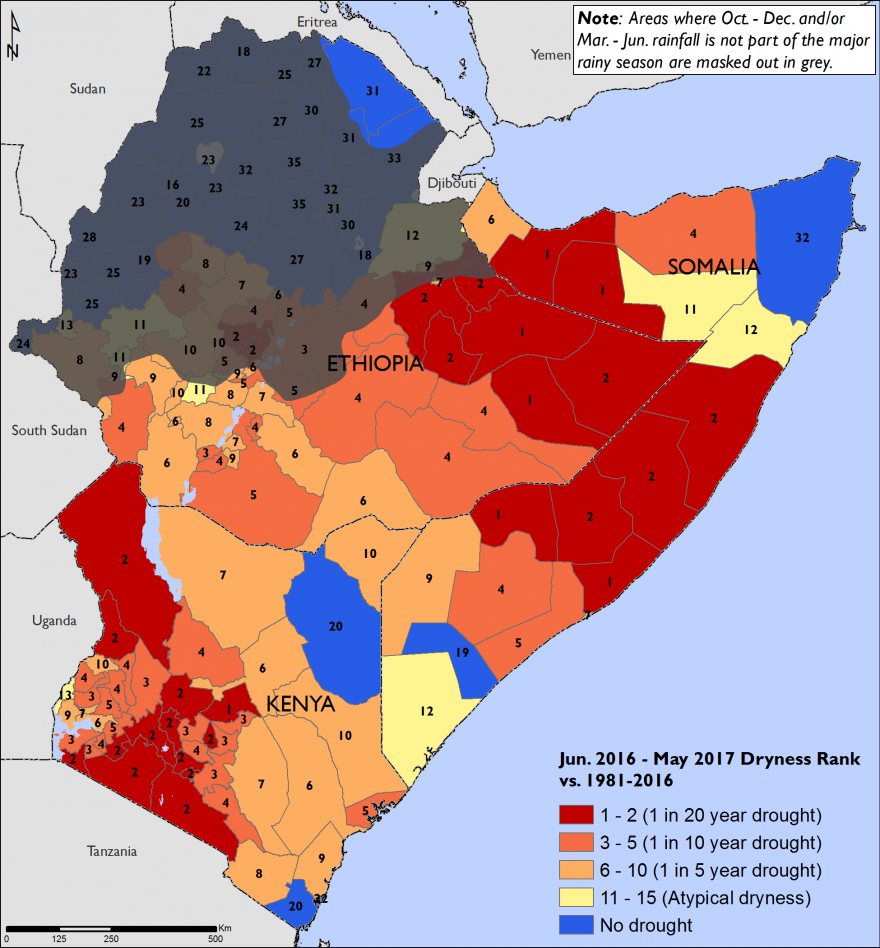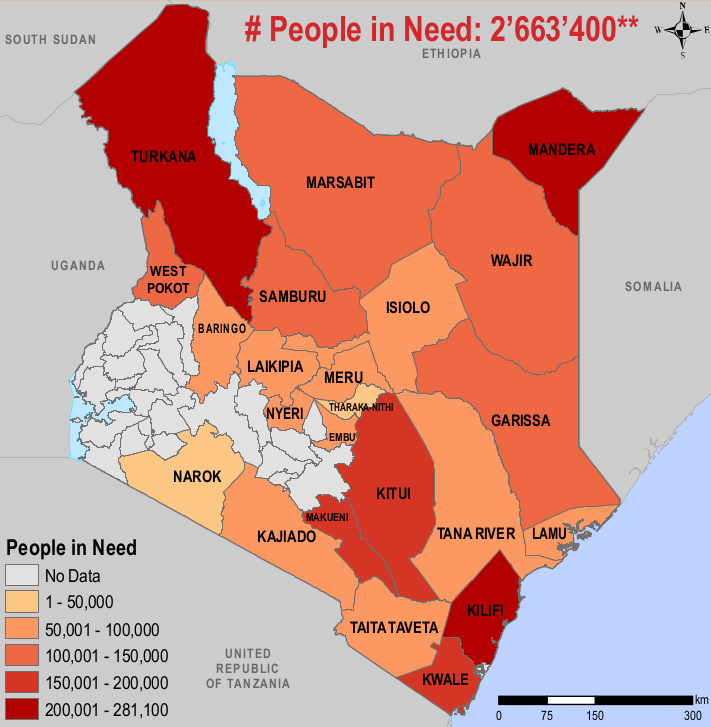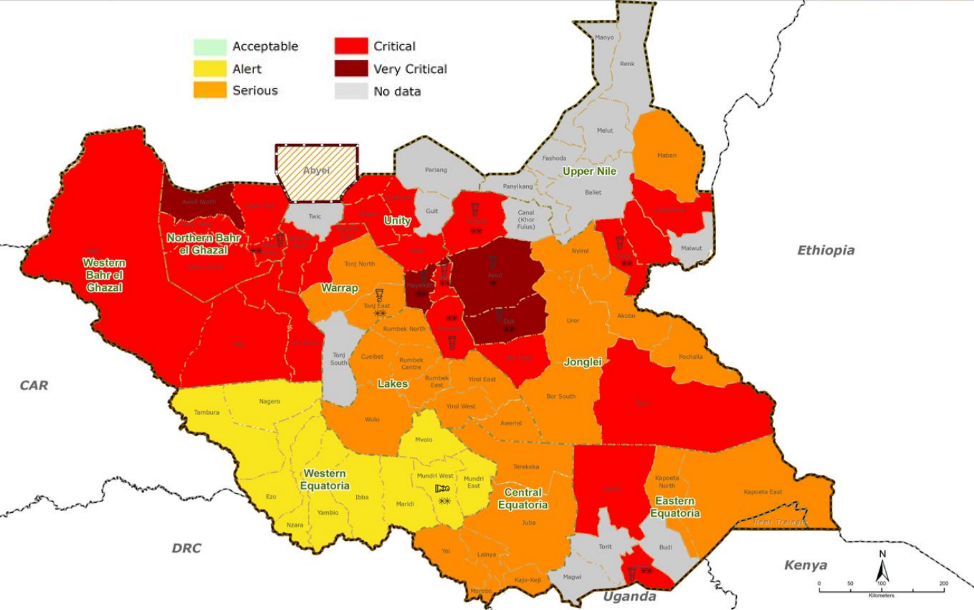East Africa is suffering a deep humanitarian crisis brought about a complex interaction between war and climate, with large refugee fluxes affecting at least seven countries. The situation is compounded by strong social inequalities, fragile governments, disorganized states and the deliberate policy of some of them to use the human suffering as a weapon. The resilience of the food production systems directly suffers from poor agricultural governance, with agriculture having been a low-priority sector sector for long time, as evidenced by under-investment and the resulting degradation of infrastructure [Note 1].
On March 10, 2017, the United Nations (UN) Under-Secretary-General (USG) for humanitarian affairs and Emergency Relief Coordinator delivered a statement to the UN Security Council about the ongoing humanitarian crisis, the largest since the foundation of the UN more than seventy years ago. The USG reported about the Lake Chad region and his missions to Yemen [Note 2], South Sudan, Somalia, and Kenya, in particular northern Kenya where pastoralists are badly affected by the drought caused by the recent very atypical El Niño. (Weblinks_1)
The region in focus here is the Horn of Africa (HoA), a region that is most eastern on the African continent and includes the countries Djibouti, Eritrea, Ethiopia, Kenya, Somalia, South Sudan, Sudan, and Uganda. As will be explored in the following sections, the current emergency in the region is exceptional on several accounts.
A man-made crisis
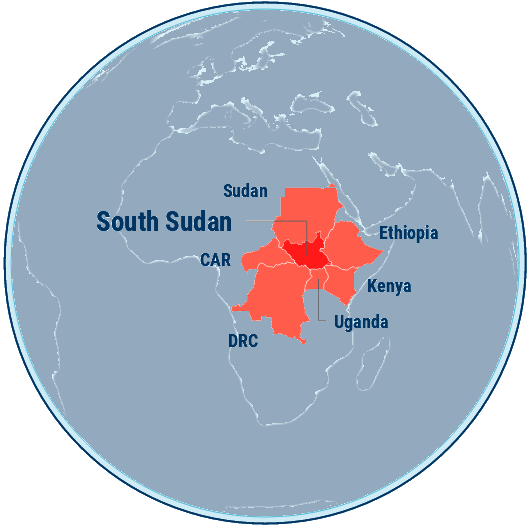
Figure 1: Countries directly affected by population movements originating in South Sudan. Source: OCHA 2017a.
The ongoing emergency is largely and undoubtedly man-made as conflict plays a major part, in particular in Syria, Nigeria, Yemen, South Sudan, and Somalia, affecting neighboring countries through refugee fluxes. With Ethiopia, Kenya, and Uganda as the main exceptions, the climate of insecurity often hampers emergency operations badly needed by local populations. According to the UN Office for the Coordination of Humanitarian Affairs (OCHA, 2017a), refugees from South Sudan are currently spread over all neighboring countries, thus affecting North Sudan, Ethiopia, Kenya, Uganda, the Democratic Republic of Congo (DRC), and the Central African Republic (Figure 1). Several of those countries are already facing their own long-term emergencies, in particular the Central African Republic (CAR) and the Democratic Republic of the Congo. In countries such as Kenya and Ethiopia, which both are already severely strained by drought, the influx of locally and internationally dispersed persons compounds the local emergency due to drought.
Finally, it is stressed that, starting with Somalia in 2011, warring parties in the region have been using food as a weapon (Weblinks_2). This may take the form of preventing aid—including food aid, medical supplies, and medical assistance—from reaching populations in need, or preventing the movement of populations to safer areas. Specifically in South Sudan, a deliberate policy of starving “enemy populations” is in place. Boys are often forcefully recruited into armed groups, while girls face sexual violence, forced marriage, and exploitation (UNICEF 2017a, 2017b).
An exceptional crisis
The crisis is exceptional in that it affects a wide geographic area. The crisis also has been ongoing for about 10 years in some areas (the Syrian civil war started in 2011, Wikipedia_1, and Boko Haram started violent actions in 2009, Wikipedia_2) and has been characterized by a complex interaction between military activities and unfavorable climatic conditions. In addition to Syria, the humanitarian crisis area is now included in an approximate triangle bounded by Yemen in the Arabian Peninsula to Lake Chad and Mali to the Democratic Republic of the Congo to Uganda.
In the HoA, the focus of this section, the situation is worse than during the previous emergency of 2010-11 (OCHA 2017c) because several areas have experienced three consecutive drought years, “exhausting people’s capacity to cope with another shock.” The drought also affects watering points for cattle and river flow, traditionally a source for irrigation in the HoA. Worst affected by drought are Somalia, east and southeastern Ethiopia, and northwestern Kenya, in an area adjacent to South Sudan (Figure 2). With the
exception of southern-central and southwest Kenya and the areas shaded in gray in the figure, most of which usually record abundant rainfall, most areas in the region are semi-arid lowlands and, more rarely, highlands that experience most of their rainy season sometime between March and June. Rainy seasons are short (sometimes just two months), making cattle the mainstay of the livelihood systems. In fact, cattle herding is an efficient system to collect dispersed biomass and concentrate it in milk and meat producing cattle. As will be mentioned below, the drought badly affected cattle, the quality and numbers of which are decreasing, thus reducing or erasing the income and overall prospects of pastoralists. As a result, cattle production and markets collapsed.
As mentioned, the HoA is part of a significantly larger spatial ensemble of insecurity (including food insecurity) that it interacts with, willingly or unwillingly. The whole area is affected by intense suffering covering the spectrum from war to famine and epidemics, constituting the first large emergency after a period of relative calm [Note 3]. Although several early warning systems for climate anomalies and food insecurity operate in the area at various scales (regional, such as AGRHYMET [Note 4] and ICPAC [Note 4], and almost all countries), they are generally ill equipped to handle the extremely complex situations that arise from the interaction of abnormal weather and war. It remains that, according to OCHA (2017c), compared with the drought of 2011, governments were now better prepared and therefore responded efficiently to the deteriorating situation; they were proactive and led the relief efforts, especially in Ethiopia and Kenya. In addition, risk management systems for farmers have been established in several countries, including the “R4 Rural Resilience Initiative” in Ethiopia (WFP 2107a) and national agricultural insurance in Kenya (KLIP 2017).
Aid requirements
Coordinated international aid and diplomatic efforts are required to help populations and countries though the crisis and limit suffering and deaths. OCHA (2017b) puts the global funding need for 2017 at US$ 23.5 billion with more than 100 million people to be targeted by humanitarian aid. Table 1 summarizes the situation in the HoA, where the total need for 2017 amounts to US$ 5.5 billion for 21.5 million people in need. Several estimates of aid requirements are available, with those estimates varying by source (e.g., OCHA, UN High Commissioner for Refugees UNHCR, or United Nations Children’s Fund UNICEF) and date, with generally upward revisions as more detailed information and analyses become available. Table 1 is based on the June 2017 Global Humanitarian Overview on the OCHA website.
Table 1: Overview of the emergency situation in the Horn of Africa. See Note 5.
|
Country |
Million people |
Funding estimate |
|||
|
Total population |
In need |
Targeted by aid |
Need for 2017 (US$ million) |
Committed as of June (%) |
|
|
Djibouti |
0.9 |
0.3 |
0.2 |
43 |
16 |
|
Eritrea |
5.5 |
n.a. |
n.a. |
n.a. |
n.a. |
|
Ethiopia |
104.3 |
5.6 |
5.6 |
949 |
28 |
|
Kenya |
48.5 |
2.6 |
2.6 |
166 |
27 |
|
Somalia |
11.4 |
5.0 |
3.9 |
1500 |
41 |
|
South Sudan |
13.1 |
6.1 |
5.1 |
1600 |
55 |
|
Sudan |
42.1 |
1.9 |
1.9 |
1200 |
8 |
|
Uganda |
41.7 |
n.a. |
n.a. |
[ >2300 (*) ] |
n.a. |
|
TOTAL |
267.5 |
21.5 |
19.3 |
5458 |
35 |
Due to the insecurity prevailing mostly in Somalia and in South Sudan, only 19.3 million people can actually be targeted, leaving 2.2 million in utmost risk and distress. In both countries, between 40 and 50% of the population is exposed to insecurity and hunger (44% in Somalia, 47% in South Sudan), while percentages of 5% to 10% prevail in Ethiopia, Kenya, and Sudan, where drought victims and displaced persons constitute the bulk of the people in need. In Djibouti, a very small and climatically vulnerable country, the population exposed to insecurity and hunger climbs to one person in 3, while for the HoA as a whole, about 8% of people are affected.
It is stressed that all refugee movements of the size of those occurring in the HoA constitute a set-back in development, with a very slow recovery curve. To start with, depending on the timing of the movements, refugees often lose their crops and livelihoods (including cattle) at home. Only if the calendar permits—and if provided with land and tools—can they produce at least part of their own food at the location of their settlement in either home or host country. Moreover, due to a stressful life and shortages, overall health declines, especially in children, which may affect them throughout their lives. Also, despite the fact that usually every effort is made to ensure schooling, refugee children typically suffer a retrogression in education that reduces their chances in life.
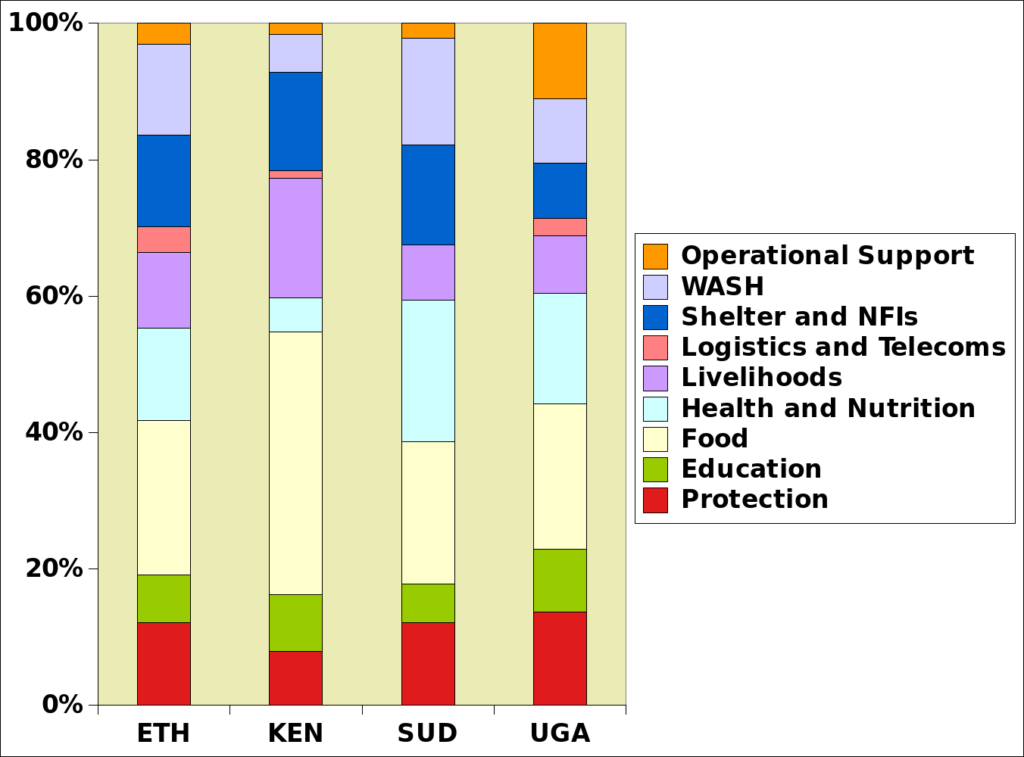
Figure 3: Financial requirements by sector in Ethiopia (ETH), Kenya (KEN), Sudan (SUD), and Uganda (UGA). Based on data in UNHCR 2017a. NFI stands for “Non Food Items.”
Figure 3, prepared with data in UNHCR 2017a, shows an estimate of the breakdown of the financial requirements by sector and by country. It is a relatively early estimate, but it is assumed that relative values will remain the same. The largest financial requirement tends to be for food (close to one third of requirements), followed by health and nutrition, livelihoods, shelter, WASH (Water, Sanitation and Hygiene) and protection, all close to 10%. In general, and on average, the first three items make up about half of the financial requirements. In Kenya, however, this percentage is larger, reaching 62%, while the percentage requirement for WASH at 6% is low when compared to other countries. It is stressed that “protection” does not address only “physical protection” (such as from Sexual and Gender-Based Violence, SGBV) but also ensures the correct registration of refugees and protection of children.
Short analysis of the situation by country
Djibouti
Insecurity in Djibouti stems partly from unfavorable rainfall and from the situation on its southwest border, which is contested between Djibouti and Eritrea. According to FEWSNET (FEWSNET 2017a), however, the situation in the country should improve from IPC phase 3 (Crisis) to 2 (Stressed) despite the fact that Qatar has recently withdrawn its peace-keeping force from the area. A contributing factor to this improvement has been generally satisfactory rainfall that has restored grazing lands.
Ethiopia
In June 2017, FAO listed Ethiopia among countries that face a “widespread lack of access to food,” stressing the impact of drought on local livelihood systems in southeastern areas and the lingering effects of the previous year’s severe drought in northern areas. Drought affected the secondary Belg season (which is chronologically the first – note 6) throughout the country, but especially crops and pastures in the south and southeastern areas (FEWSNET/WFP 2017). Meanwhile, the effects of the 2015 drought continued to impact local livelihoods in northern areas. Altogether, FAO estimates that 7.8 million people are food insecure (FAO 2017b), mostly in pastoral areas. The main season (Meher – note 6) is not particularly affected so far, or only in limited pockets.
Importantly, the notable coping capacity of the country is strained by the influx of South Sudanese fleeing war and Somalis fleeing drought impacts. As of July 15, the total number of Somali refugees in Ethiopia has reached 250,000 people, while the total number of South Sudanese refugees in the country was 380,000 (OCHA 2017d). FAO puts the financial requirements to assist refugees in Ethiopia in the agricultural sector at US$ 5.88 million (UNHCR 2017).
The problems are most serious in pastoralist areas, some of which have suffered three years of consecutive drought. As a result, some 5.6 million people in Ethiopia require emergency food assistance in 2017 (OCHA 2017c). FAO preliminary estimates suggest that up to three million cattle, calves, and milk cows have died, representing up to 90 percent of the total in some areas (Weblinks_3).
FAO (2017b) did not, however, rank Ethiopia among the countries in need of external assistance, as the main Meher crop is to be harvested between now and the end of the year, and because the country is large and diverse, with highlands usually well-endowed with rainfall. This may change, however, as about 150 thousand hectares of Belg [6] cropland are estimated to have been hit by fall armyworm, affecting 6 of the 11 states. The impact was most severe in the Southern Nations, Nationalities and Peoples’ State (SNNPS), where about 10,000 people are affected (ACAPS 2017b). The armyworms may also affect the main season crops, and the climate of uncertainty is affecting the price of maize (figure 4). Over the last 3 months, the price of maize was up 9.2% (on average, it increases 5.1% over the same period), while for the last year the increase is 3.4% (instead of an average decrease of 0.7%) (FAO 2017c).
Across the country, currently 7.9 million people receive food aid. On July 31, OXFAM (2017) warned that the southeastern Somali region (which borders Somalia, figure 5),
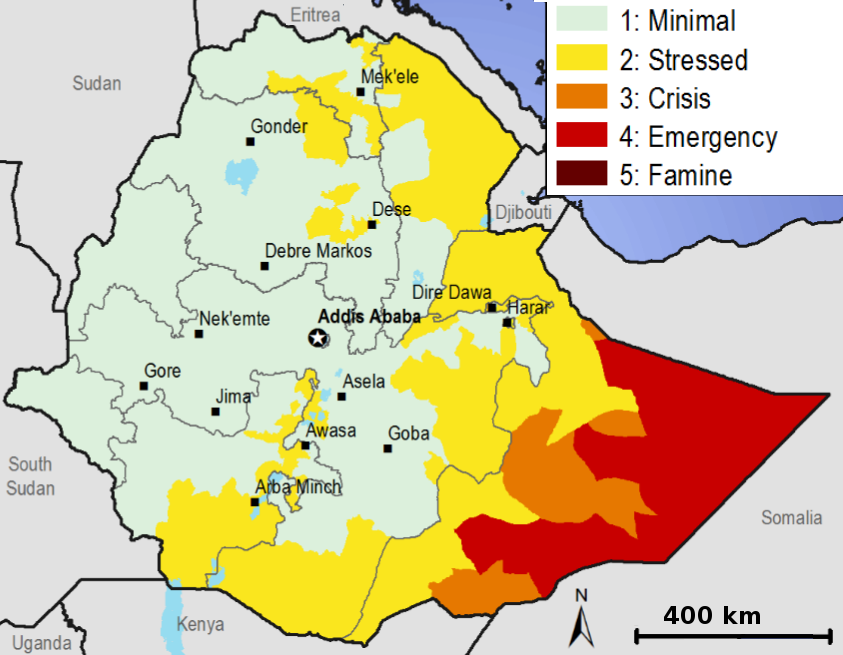
Figure 5 : Projected food security outcome, October 2017-January 2018. Source: Modified from FEWSNET/WFP 2017.
especially Dollo and Korahi zones, which are currently in phase 4, may be pushed into IPC phase 5 (famine) if food is not received urgently, among others to reduce excess mortality among children. Nationwide, the number of severely malnourished children exceeds 300,000. FEWSNET also stresses that serious human disease is ongoing (FEWNSET 2017d, FEWSNET/WFP 2017).
Eritrea
Eritrea is absent from virtually all accounts of the situation in the HoA, which is surprising given the similarities in climate with neighboring areas in Ethiopia, Djibouti, and Sudan. According to the World Food Programme (WFP) Seasonal Explorer (WFP 2017c), most of the country did experience a wet spell (above-normal rainfall) in April, followed by about average rain and a bout of drought in July. In fact, the Climate Prediction Center (CPC) Outlook (CPC 2017) classifies parts of the country as suffering from “abnormal dryness.”
Kenya
At the beginning of the year, 23 out of Kenya’s 47 counties were affected by drought, and Kenya’s government declared a national emergency (figure 6). The number of food insecure people more than doubled—from 1.3 million to 2.7 million, with hundreds of thousands of children acutely malnourished. Global Acute Malnutrition (GAM) reaches values above 30% in the north of the country, in the north of Turkana district (which borders South Sudan and Uganda), north Hor Constituency (Marsabit district), and in Mandera, on the border with Somalia and Ethiopia. Six sub-counties (Turkana Central, Turkana South, and Turkana West, Laisamis (Marsabit), East Pokot (Baringo), and Isiolo) have GAM rates between 15 and 29% (OCHA 2017c).
Although the listed areas are semi-arid, they usually cultivate some maize. Production fell dramatically (up to 100%), and large numbers of animals died in Turkana, Marsabit, Samburu, and Mandera counties. Data collected by UNICEF from 10 affected counties indicates that close to 175,000 children are not attending early pre-primary and primary schools, primarily due to the drought’s impact. The African Development Bank (AfDB) has approved a US$ 1 million grant as emergency relief for the involved areas (All-Africa 2017) where about 1 person in 5 is affected.
OXFAM (2017) assumes that the people in need of humanitarian assistance due to drought will have reached 3 to 3.5 million in August. FEWSNET 2017c expects the crisis situation to subsist until November when the short rains will be underway. For poor pastoral households in the northern central and eastern regions, the crisis (IPC phase 3) may continue into 2018. This year’s long rains (March to May) were well below average in most of the country, except in the southern-central and southwestern highlands in an area from Central Region (where elevation usually exceeds 2,500 meter with moderate drought) to the regions of Nyanza and Western across the southern rift valley, where elevation is mostly close to 1,500 meter and where rainfall was average. Comparable to Ethiopia, maize prices are high and armyworm outbreaks are likely to worsen already stressed maize crops.
Somalia
In Somalia, about 95% of the rural population face poverty, according to the UN (2016), and close to one person in ten is internally displaced. The country suffered a severe famine in 2011. Since November 2016, 770,000 people have been displaced by drought, including 28,000 in June 2017 alone. About 17,000 settled in the cities (UNHCR 2017b).
According to FAO (2017a), “The two consecutive seasons of poor rainfall in 2016 created a domino effect of losses” that also extended to livestock. About 5 million people in the country are affected by food insecurity with about 1.4 million in IPC phase 3 (crisis). The situation is expected to worsen and reach its peak during the Jilaal season (dry season from January to March).

Figure 7: Preliminary projection of the IPC phase in Somalia at the end of 2017. Source: FSNAU, 2017a.
Based on a survey it conducted in June 2017, FAO’s Food Security and Nutrition Analysis Unit (FSNAU) (2017a) assesses that security outcomes and humanitarian needs are expected to persist in most parts of Somalia through the end of 2017 (figure 7). In some areas where livestock is the mainstay of livelihood systems (mostly in the central-western and northern parts of the country including Mudug, Galgadud, Gedo (which borders northeast Kenya), Middle Shabelle and Lower Shabelle regions), food security may deteriorate between now and the end of the year. Depending on the amount and nature of the assistance that will be provided to Somalia, local famine (IPC scale 5) cannot be excluded.
The ongoing drought in Somalia has cost the country close to US$ 2 billion in livestock and crop losses, the World Bank has said. The Bank also warns that the drought is “likely to have cast widespread and lingering impacts across multiple sectors in the country” (Weblinks_3).
South Sudan
According to UNHCR (2017), “prospects for the implementation of the Agreement on Resolution of the Conflict in South Sudan (ARCISS) remain bleak.” Mostly as a result of inter-communal violence, by the end of 2017 about 15% of the South Sudanese population will have left the country, an increase of about 20% over March 2017 figures. Most will temporarily settle in Uganda (more than 1 million, figure 8), while others will go to Ethiopia and the Sudan (between 400 and 500 thousand), Kenya and the Democratic Republic of the Congo (about 100 thousand in Kenya), and the Central African Republic (about 10 thousand). While most of those countries already face hardship due to drought or human induced stresses or sometimes both, they nevertheless offer a level of protection unavailable in South Sudan. Still according to the quoted UNHCR source, the bulk of the assistance will go to food (24%), followed by health and nutrition (15%) and protection (12%). WASH (Water, Sanitation and Hygiene), livelihoods, and “shelter and non-food items” (such as tools) will require about 10% each of the assistance. It is stressed that countries that host refugees have to make camp sites available, and that refugees will often grow food if provided with suitable land and tools. Efforts are also made to ensure biometric registration of people, schooling, and access to telecommunications.
The IPC maps for South Sudan (figure 9) show critical and very critical (famine) conditions in parts of northern, central, and western South Sudan. The most critical situation is projected for northeast Lol State (Bahr el Ghazal), Western Bieh, and the northern part of Southern Liech, with both states located in the upper Nile region.
According to UNICEF (2017a, 2017b), about 50% of the people at risk are children. I addition to their exposure to the same risks as adults, children are also the victims of
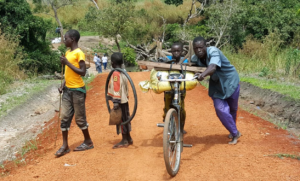
Figure 8: South Sudanese refugees arriving in Uganda by bicycle at an unofficial border point. Source: UNHCR 2017a.
outbreaks of cholera and measles. Malaria remains the first cause of morbidity among young children (under 5.5 years). Less than half the South Sudanese children still attend school.
Sudan
The Darfur crisis in the western Sudan started in the 1980s, peaked in 2003, and recently resumed in April 2017 (ACAPS 2017c) after several short-lived cease-fire arrangements. OCHA (2017e) states that about 2.3 million vulnerable IDPs need humanitarian assistance across Sudan, including 2.1 million in Darfur and 240,000 in Blue Nile and South and West Kordofan states. The vulnerable population also includes about 250,000 returnees who went back to Sudan between 2014 and 2017. In the Darfur region, 58% of IDPs and 78% of South Sudanese refugees were food insecure as of May 31, 2017. The region is currently in its rainy season, and bad road condition is, next to insecurity, the major obstacle to the delivery of food aid. Altogether 4.8 million people need humanitarian assistance of which 17% are refugees, about half are IDPs (48%), and 36% are residents and returnees (5%). One in six children (2.2 million) is estimated to be acutely malnourished. According to UNHCR (2017a), FAO estimates the requirements to assist with refugees in the agricultural sector at US$ 4.34 million. Figure 10 shows areas of major humanitarian concern in the country.
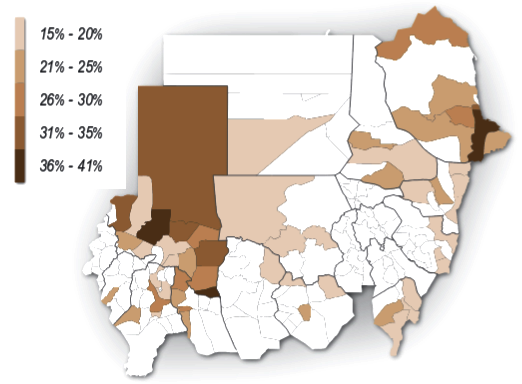
Figure 10: Areas where Global Acute Malnutrition exceeds 15% in Sudan. Source: OCHA 2017e, based on government data, modified.
Uganda
According to UNHCR 2017, “From July 2016 through January 2017, more than 512,000 South Sudanese refugees arrived in Uganda at an average of 2,400 refugees per day.” By early June, the total number had risen to 955,000 (ACAPS 2017a). Most settled in the West Nile district and depend on external assistance for their livelihoods, such as for food, WASH and medical services (no cholera cases are reported this year). The percentage of those refugees with access to land suitable for farming does not exceed 50%. FAO estimates the financial requirements to assist refugees in the agricultural sector to be US$ 10.32 million (UNHCR 2017).
The government of Uganda has had a very “open” strategy towards refugees, with the objective that they “take care of themselves” as far as possible. For instance, their movements are not restricted, they are allowed to work, have acc between local people and refugees have been reported in the northwest where most Sudanese refugees are based. The southern half of the country hosts about 350 thousand refugees from Democratic Republic of the Congo, Somalia, Rwanda, and Burundi.
Notes
Note 1: Under-investment in agriculture was one of the main drivers of the 2008 crisis of high food prices (Mittal 2009, ATV 2010), even if several other local and global triggering factors can be identified (Evans 2008).
Note 2: Although Yemen is not part of the Horn of Africa (HoA), it is geographically close to the Horn and maintains close links to the region. The countries of the HoA are grouped in the regional development association IGAD (Inter-governmental Authority on Development, with headquarters in Djibouti). IGAD has recently established the IGAD Drought Disaster Resilience and Sustainability Initiative (IDDRSI, 2016)
Note 3: Previous large humanitarian crises were those of the West African Sahel (from the early sixties to the mid eighties), the Ethiopian droughts of the mid-eighties, the Indian Ocean tsunami of 2004, several large earthquakes (Haiti, 2010), floods and medical emergencies (West African Ebola outbreak, 2013-16).
Note 4: See the home pages of AGRHYMET and ICPAC. AGRHYMET is mentioned in the broader context of African geomatics centers elsewhere in this blog.
Note 5: The table is based on OCHA (2017b) for emergency data and FAOSTAT (FAOSTAT 2017) for total population (2017 estimates). * The “Need for 2017” value estimate for Uganda was computed based on an earlier estimate in UNHCR (2017a) multiplied by a factor derived from the comparison of UNHCR 2017a and OCHA 2017b. Values between brackets are not included in the total.
Note 6: Agriculture is extremely complex in Ethiopia due to the country’s location relatively close to the equator (which results is one of two rainy seasons in some areas), compounded by high elevation (Ethiopia is one of the few countries with frost risk in agriculture in Africa). The two major cropping seasons are known as Belg and Meher (main). Given the diversity of climatic situations, planting occurs continuously from February to August. Belg includes the crops that are harvested up to July. Crops harvested from August (up to December) are assigned to the Meher season and include the preferred staple, teff, which accounts for about 25% of cereals produced in the country.
References
Weblinks_1(Overview) Reliefweb, Liberation, Aljazeera.
Weblinks_2 (Food as weapon) Globaltimes, Washingtonpost, Aljazeera, Allafrica, Midnimo.
weblinks_3 (Cattle) Allafrica, CNN, Goobjoog, Caritas.
ACAPS 2017a Uganda briefing note, Influx of South Sudanese refugees straining resources.
ACAPS 2017b Ethiopia Fall Armyworms infestation in Sidama zone, SNNP.
ACAPS 2017c Sudan Briefing Note, Conflict in Darfur.
All-Africa 2017 http://allafrica.com/stories/201707170515.html
ATV 2010 Recommendation report: food for all forever. Danish academy of technical sciences (ATV), Copenhagen,
CPC 2017 Climate Prediction Center’s Africa Hazards Outlook August 10 – August 16 2017.
Evans A 2008 Rising Food Prices: Drivers and implications for development. London: Chatham House.
FAO 2017a Rapid results Drought response plan Somalia 2016/17. FAO, Rome and THIS LINK.
FAO 2017b June 2017 crop prospects and food situation quarterly global report. FAO, Rome. Also consult THIS LINK.
FAO 2017c http://www.fao.org/giews/food-prices/price-warnings/en
FAOSTAT 2017 http://www.fao.org/faostat/en/#data/OA
FEWSNET 2017a Djibouti remote monitoring update.
FEWSNET 2017b East Africa Food Security Alert of July 6, 2017. Link_1 and Link_2.
FEWSNET 2017c June 2017 to January 2018 Kenya Food Security Outlook.
FEWSNET 2017d Ethiopia food security alert 3 August 2017.
FEWSNET/WFP 2017 Ethiopia Food Security Outlook June 2017 to January 2018.
FSNAU 2017a Food Security & Nutrition Quarterly Brief – Focus on Post Gu 2017 Season Early Warning.
IDDRSI 2016 IGAD Drought Disaster Resilience and Sustainability Initiative.
KLIP 2017 Kenya Livestock Insurance Programme.
Mittal A 2009 The 2008 Food price crisis: rethinking food security policies. G-24 Discussion Paper No. 56.
OCHA 2017a Global humanitarian overview, June 2017 status Report. UN New York.
OCHA 2017b http://interactive.unocha.org/publication/globalhumanitarianoverview
OCHA 2017c Horn of Africa. A call for action.
OCHA 2017d Weekly humanitarian overview 24 July 2017 and THIS LINK.
OCHA 2017e Sudan humanitarian snapshort 30 June 2017.
OXFAM 2017 Horn of africa drought response, Issue 2, 31st July 2017. OXFAM.
UN 2016 Somalia 2016-2018 humanitarian strategy.
UNCEF 2017b https://www.unicef.org/appeals/south_sudan.html
UNHCR 2017a South Sudan regional refugee response plan – Revised, January – December 2017.
UNHCR 2017b Somalia drought displacements in period 1 Nov 2016 to 30 Jun 2017.
UNICEF 2017a 1 January – 20 July 2017: South Sudan SITREP #111.
WFP 2017a The R4 Rural Resilience Initiative.
WFP 2017b http://dataviz.vam.wfp.org/economic_explorer/prices
WFP 2017c http://dataviz.vam.wfp.org/seasonal_explorer
Wikipedia_1 https://en.wikipedia.org/wiki/Syrian_Civil_War
Wikipedia_2 https://en.wikipedia.org/wiki/Boko_Haram consulted on 20170807.
WSD 2017 WASH Sector Dash boardKenya drought 1 January 15 June 2017.
